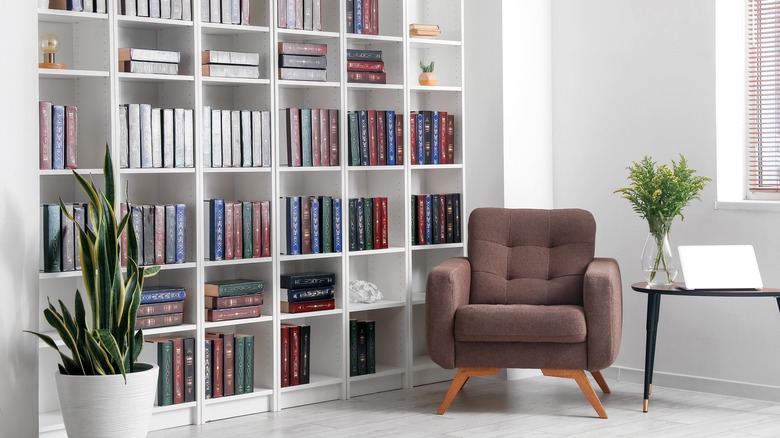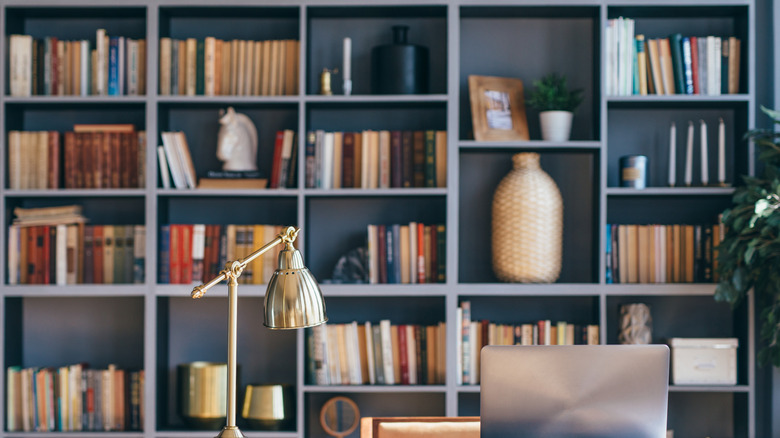Why You Should Stick To The Two-Thirds Rule When Organizing Your Bookcase
Whether your bookcase is floor-to-ceiling, has open or closed sides, or has glass doors, organizing it with a plan and flair has taken the place of the casual, random book piles of yore. Adapting the design rule of thirds to the contents of a bookcase is a practical and creative way to display your books while restoring order to chaos. That is to say, only two-thirds of each shelf should be devoted to the books, and the rest left empty or filled with other items.
One Good Thing agrees that arranging a bookcase according to the two-thirds rule is an essential design trick. Observing this concept results in a bookcase that is visually balanced, and more interesting and less busy to look at than an overstuffed one. Aesthetics aside, it is easier to pull books out of a case that is only partially full. It is also better for the bookcase, and there is less wear and tear on spines and dust jackets. Reader's Digest suggests a variation of the two-thirds approach: one-third for books, a third for decorative items, and the last segment having no contents at all.
Bookcase organization has many purposes. Is self-expression the raison d'etre, or is it for one's personal satisfaction? Perhaps the arrangement is strictly functional, designed to impress, or simply meant to look nice. In any case, influenced by the two-thirds rule, many designers and bibliophiles are favoring partially loaded bookcases completed by art, vases, photos, or other objects.
Organizing with the two-thirds rule
Whatever the motivation, a well-balanced, visually pleasing bookcase can be achieved in a number of ways while keeping the two-thirds rule in mind. Books can be arranged by height or color, or grouped by author, title, subject, or genre. Ones that have been read can be separated from unread books, and favorites can get a place of honor. Carefully arranged bookshelves bring order to the room and reduce clutter while also serving as a focal point. Organizing a case using the two-thirds principle also allows room for additional volumes. Penguin UK suggests creating a sense of movement by varying the placement of each third on every shelf.
To prepare a bookcase, a good tip is first to remove everything and then clean the shelves. Before refilling them, cull unneeded books for donation to libraries or thrift outlets. A stack of books makes a sturdy bookend, as will a plant, heavy art object, or even a conch shell placed on the unused third. Designer Shannon Claire Smith, as quoted in the Washington Post, suggests groups of only a half dozen books placed together on a shelf, with objects or space between them. Another organizing method is to use multiple bookshelves, each devoted to a particular type of book. Better By Today suggests placing them where appropriate, such as putting a cookbook case in the kitchen. Valuable books or first editions can be safely stored dust-free in a bookshelf with glass doors.
Other ways to organize your bookcase
Artist Kate Moynihan emphasizes the thirds concept as beneficial to balance, structure, and composition. According to GharPedia, a bookcase organized in the two-thirds/one-third manner can be the focus of any room, and the empty spaces add to its visual appeal. Craftionary suggests that, instead of books, a bookcase's empty portions are useful for storage containers to control clutter.
For optimum organization, books can be alphabetized by the writer's last name, with each title similarly ordered within that group. Arranging by height, subject, or genre is a suggestion. Books from certain publishers usually have complementary designs and can be displayed as a group. Volumes in a series can be kept together as well. Matching books of the same hue or removing a drab dust jacket might add color to the display. One might even put labels on the bookcase to indicate each category. Paperbacks can be kept away from hardbound books with art pieces or photos placed between them for separation and visual effect. Volumes can be stored vertically or piled horizontally for variety.
Leslie Wendell Dye in The Atlantic mourns that the art of book organizing might eventually fall by the wayside at the hands of Kindle and other electronic reading devices. However, whereas Kindles will never serve as an interior design staple, a well-organized bookcase will always possess a timeless appeal.


